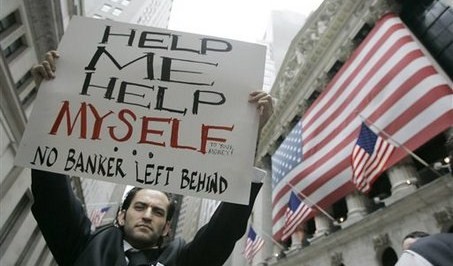

It's all about leverage. We've been waiting for this public quote for 2 1/2 years. It's very simple math. And it's also the key to understanding the crisis and why all of the banks are so deeply insolvent. You've heard it several times here before. Henry Paulson, when he was still CEO of Goldman in 2004, successfully lobbied the SEC to change the rules on capital ratios. Leverage exploded from a previous limit of 12:1 to beyond 40:1 for all 5 firms, and when you consider that a substantial portion of the assets were synthetics then the real leverage numbers were much higher.
---
Ratigan details Paulson's rarely mentioned role in the crisis...
Watch this from Dylan Ratigan and read the story below from the NY Times on Henry Paulson:
By the way, reinstating the pre-2004 rules of 12:1 would go a long way toward a financial fix and yet it was left undone by Dodd-Frank, which only required that the Federal Reserve undertake a study of capital ratios and report findings to Congress. That will certainly solve the problem.
Back to the math. In a world of 40:1, assets don't have much downside. Consider what this means in a simple example.
- If your collective assets drop in value from 100 to 97, you're done. Toast. Game over. At least that's how it's supposed to work.
Here's a further illustration.
Goldman Sachs could have $1 trillion in assets anchored by just $25 billion in capital. Assume Goldman's asset base loses 30% in value as happened in 2008, creating a paper loss of $300 billion, which if they were forced to mark honestly, would leave them insolvent to the tune of approximately $275 billion. This is what I mean when I've written before that the banks aren't just a little bit insolvent, instead their insolvency depth is a multiple (in this case 6x) of their original capital.
Adam Levitin testified last month to Congress that an honest accounting of JUST second lien loans - helocs and nothing else - not CMBS, not RMBS - just home equity loans - that this would instantly wipe out the entire capital base for each of the 4 largest banks - Citigroup, JPMorgan, Wells Fargo and Bank of America. Poof, and gone. And I'll say it 1 more time - that's just for helocs.
Now remember 'insolvent by multiples' as you consider the $144 billion paid out in bonuses in 2010 by a collective of bailed-out, bankrupt banks.
But none of that matters anymore, not since the FASB rule change. Now it's a game of super-galactic Texas bullshit as each and every bank survives by the foreskin of their mismarked assets, all with the blessing of Congress, CNBC, accounting regulators, Sheila Bair, Tim Geithner, Obama and the Ber-nank.
Now onto the story from Reuters, who got an advance look at the report from Phil Angelides and the Financial Crisis Commission due to be released later Thursday.
----
Financial Meltdown Was 'Avoidable,' Crisis Panel Finds
The financial crisis could have been avoided and was the result of poor decision making both in Washington and at top financial firms that fostered a culture of excessive risk taking, according to a draft report written by Democrats on a panel that investigated the meltdown and obtained by Reuters.
The Democratic majority of the 10-member Financial Crisis Inquiry Commission spreads the blame widely to regulators, politicians, financial firms and credit rating agencies.
The report will be officially released on Thursday but it has been endorsed only by the congressionally appointed panel's six Democratic commissioners. Three Republican members will release a separate minority report and a fourth Republican plans to unveil a report of his own that will focus on government housing policies.
Among regulators the report singles out former Federal Reserve Chairman Alan Greenspan and his successor Ben Bernanke. The report faults Greenspan and his allies for pushing the idea that financial institutions could "police themselves."
Bernanke and former Treasury Secretary Henry Paulson were criticized for not seeing the problems in the subprime mortgage markets earlier.
Clinton administration officials were rebuked for pushing to shield over-the-counter derivatives from regulation.
As for the corporate chieftains at the large financial firms that were either toppled or brought to their knees by the crisis, the panel says its examination found "stunning instances of governance breakdowns and irresponsibility."
Among those singled out are American International Group, mortgage giant Fannie Mae and Merrill Lynch.
The report faults investment banks Bear Stearns, Goldman Sachs, Lehman Brothers, Merrill Lynch and Morgan Stanley for "operating with extraordinarily thin capital" in 2007.
- "Less than a 3 percent drop in asset values could wipe out a firm," according to the report.
The report criticized credit rating agencies such as Moody's Corp, McGraw-Hill Cos' Standard & Poor's and Fimalac SA's Fitch Ratings for giving "their seal of approval" to securities that proved to be far more risky than advertised because they were backed by mortgages provided to borrowers who were unable to make payments on their loans.
The report also discussed the role played by "shadow banking," or unregulated financial firms, the securitization of private mortgage debt and over the counter derivatives.
---
 DailyBail
DailyBail